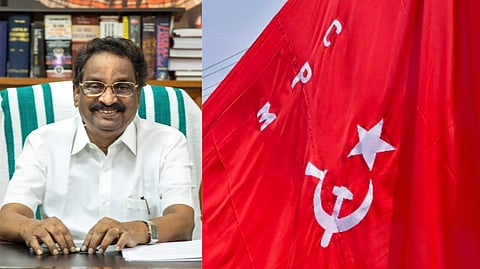

“It is time to make sincere efforts to protect the party symbol,” said AK Balan, a senior leader of the Communist Party of India (Marxist) and a former minister in Kerala’s Left cabinet while speaking at a function in Kozhikode on March 23. “Otherwise, the party will be forced to fight the elections on symbols like the octopus or pangolin in future,” he added.
Inaugurating the Kerala State Financial Enterprises Officers Union (KSFEOU) leadership workshop in Kozhikode, Balan said if the party fails to secure a certain percentage of votes and win seats in the upcoming Lok Sabha election it will lose its national party status, and risk losing even its election symbol - the famed Hammer, Sickle and Star.
In September 2023, the Communist Party of India (CPI) lost its national party status along with the Trinamool Congress (TMC) and the Nationalist Congress Party (NCP). However, the Aam Aadmi Party was recognised as a national party with their presence in four Indian states, Delhi, Goa, Punjab and Gujarat.
In India, six parties are currently considered national parties - the Congress, Bharatiya Janata Party (BJP), National People’s Party (NPP), Bahujan Samaj Party (BSP), AAP and the CPI(M).
Criteria for national parties
A national party would have a presence nationally while a regional party has presence in a particular region or state. The Election Commission of India has set certain criteria for parties if they are to be conferred national or state party status.
According to the Election Commission of India, a political party shall be treated as a recognised National party, if the candidates fielded by the party in any four or more states during the last general election to the Lok Sabha, or to the Legislative Assembly of the state concerned, have secured not less than 6% of the total valid votes polled in their respective states during the general election.
In addition, the party should have won at least 2% of the total number of seats in the Lok Sabha (any fraction exceeding half being counted as one). This would mean that in a house of 543 seats, the party would need 11 seats. The party’s candidates should also be elected to the house from not less than three states. In addition, it should be recognised as a state party in at least four states.
CPI(M)’s performance in the last election
In the 2019 Lok Sabha polls, the CPI(M)-led Left Democratic Front (LDF) won one seat out of the 20 in Kerala. It was AM Ariff in the Alappuzha constituency. Overall, in the 2019 Lok Sabha election, the CPI(M) secured three Lok Sabha members including one from Kerala and two from Tamil Nadu, with a vote share of 1.75%. It also has five seats in the Rajya Sabha.
Twenty years ago in 2004, the CPI(M) had 43 seats, including 26 from West Bengal, 12 from Kerala, two from Tamil Nadu, two from Tripura and one from Andhra Pradesh and a vote share of 5.66%. In 2014, CPI(M) reduced to nine seats, including five from Kerala, two from West Bengal and two from Tripura and a vote share of 3.6%. In 2019 this came down to 1.75%.
The CPI(M), which has an alliance with the Dravida Munnetra Kazhagam (DMK) has been given two seats in Tamil Nadu. In Sikar LS constituency in Rajasthan, the party has fielded a candidate backed by INDIA Alliance. In West Bengal, the party has announced candidates in 20 seats. The CPI(M)-led Left Front in Tripura has a seat sharing agreement with Congress and has put up a candidate in East Tripura constituency.
This time the party has fielded all candidates under the party symbol in Kerala, including independents backed by them to shore up the vote share.
Currently, CPI(M) has domination in Kerala, where the party won 62 seats out of 77 Assembly constituencies in which they fielded candidates. The Left Democratic Front (LDF) led by the CPI(M) has 98 MLAs while the Opposition UDF has 41 MLAs. One seat is vacant. Apart from Kerala, CPI(M) is recognised as a state party in West Bengal, Tamil Nadu and Tripura. In Tamil Nadu, the party has two MLAs, while in Tripura it has 11 and also serves as Opposition. However, in West Bengal, it doesn’t have any seats.
Benefits of being a national party
Reserved party symbols are a privilege of national parties. The party can use that symbol for all elections held in the country. But the CPI has not lost the symbol despite losing the national party status. There are some other benefits too, a national party can get land from the government to build its headquarters. The party would get free broadcast time on state-run television and radio, consultation in the setting of election dates, and provide inputs for setting electoral rules and regulations.
As per the Election Symbols (Reservation and Allotment) Order, 1968, the continuity of symbols is allowed in case of a political party, which is unrecognised at present but was a recognised national or state party in any state (not earlier than six years from date of notification of election) fields candidates. This shows a political party does not face the risk of losing the symbol immediately even if it gets derecognised.
The Election Commission of India also places restrictions on the allotment of symbols reserved for state parties in states where such parties are not recognised. A symbol reserved for a state party in any state will not be included in the list of free symbols for any other state or Union Territory and will not be reserved for any other party which subsequently becomes eligible.